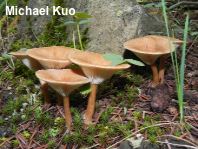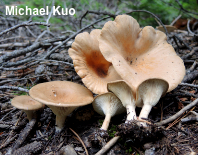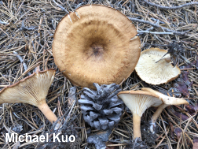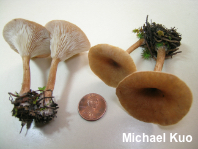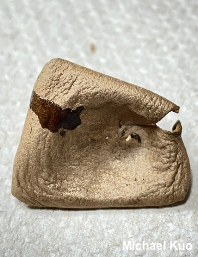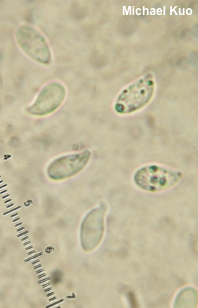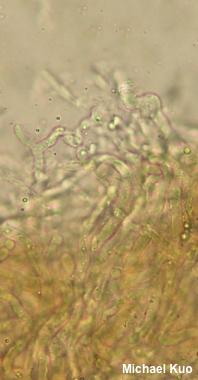| Major Groups > Gilled Mushrooms > Pale-Spored > Clitocyboid Mushrooms > Infundulicybe squamulosa |

|
Infundibulicybe squamulosa [Basidiomycota > Agaricales > Tricholomataceae > Infundibulicybe...] by Michael Kuo This clitocyboid mushroom appears under conifers, and features a vase-shaped, orange-brown cap and stem, along with pale gills. In North America Infundibulicybe squamulosa is primarily northern and montane. It is quite similar to Infundibulicybe gibba, which grows under hardwoods, but the colors of Infundibulicybe squamulosa are generally darker, especially on the stem; additionally Infundibulicybe squamulosa has larger spores and, after drying, a cap that turns brown with KOH. On our continent, Bigelow (1985) named two western varieties, var. montana and var. sicca, which he separated on spore morphology; he thought the typical variety was limited to northeastern North America and the upper Midwest. Whether or not these concepts could be applied in a contemporary, DNA-informed setting is unclear. In Europe, Infundibulicybe squamulosa should be compared, not only with Infundibulicybe gibba, but also with Infundibulicybe sinopica (colors a bit more red, odor mealy), and with Infundibulicybe costata (cap edge often becoming ribbed, pileipellis a cutis in the cap center rather than a trichoderm). I have my doubts about the latter species, but I should probably keep them to myself. Oops. Clitocybe squamulosa is a synonym. Description: Ecology: Saprobic; growing scattered or gregariously; under conifers on moss or in needle duff; spring through fall; originally described from Europe, where it is widespread (but more common in northern and montane regions); in North America also primarily northern and montane. The illustrated and described collections are from Colorado. Cap: 3–10 cm across; at first planoconvex with a central depression, becoming vase-shaped; dry; bald or with very small fibrillose scales, especially toward the center; orange-brown to pale orangish tan; the margin not usually lined but sometimes becoming ribbed or even scalloped and wavy. Gills: Running down the stem; close; short-gills frequent; white or pale cream, sometimes becoming faintly brownish in old age. Stem: 2.5–5 cm long; 6–13 mm thick; equal above a slight basal bulb that is usually buried in duff; dry; bald or finely scurfy; colored like the cap; base covered with white mycelium. Flesh: Thin; whitish or watery; unchanging when sliced. Odor and Taste: Not distinctive. Chemical Reactions: KOH on fresh cap surface negative top grayish; on cap surface of dried herbarium specimens brown. Spore Print: White. Microscopic Details: Spores 5–10 x 3–5 µm; amygdaliform or ellipsoid; smooth; inamyloid; hyaline in KOH. Basidia 28–34 x 4–6 µm; clavate; 4-sterigmate. Cystidia not found. Pileipellis a cutis, with upright aggregations of hyphae toward the cap center; elements 4–8 µm wide, smooth or encrusted, hyaline to orangish brown in KOH; exserted terminal cells cylindric with rounded apices; clamp connections present. REFERENCES: (C. H. Persoon, 1801) H. Harmaja, 2003. (Fries, 1821; Saccardo, 1887; Bigelow, 1985; Schalkwijk-Barendsen, 1991; Kuyper, 1995; Harmaja, 2003; McNeil, 2006; Gregory, 2007; Nonis, 2007; Trudell & Ammirati, 2009; Buczacki et al., 2013; Desjardin, Wood & Stevens, 2015; Sturgeon, 2018; Vesterholt, 2018; Læssøe & Petersen, 2019; Kibby, 2020.) Herb. Kuo 08061002, 08021704, 07271902, 07281902. This website contains no information about the edibility or toxicity of mushrooms. |
© MushroomExpert.Com |
|
Cite this page as: Kuo, M. (2022, July). Infundibulicybe (Clitocybe) squamulosa. Retrieved from the MushroomExpert.Com Web site: http://www.mushroomexpert.com/infundibulicybe_squamulosa.html |
